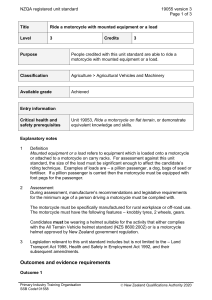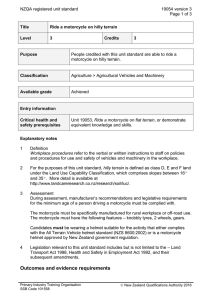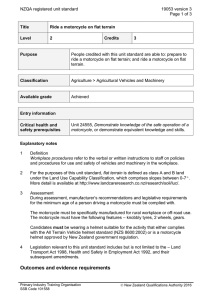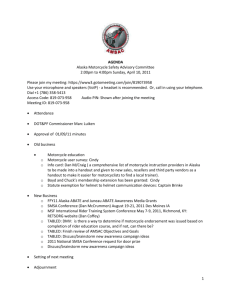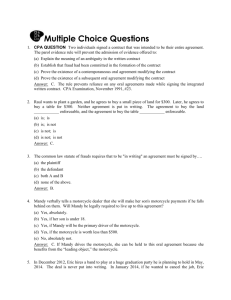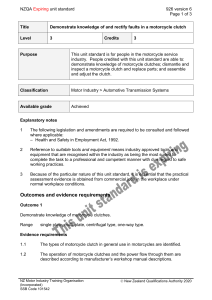NZQA registered unit standard 24555 version 2 Page 1 of 3
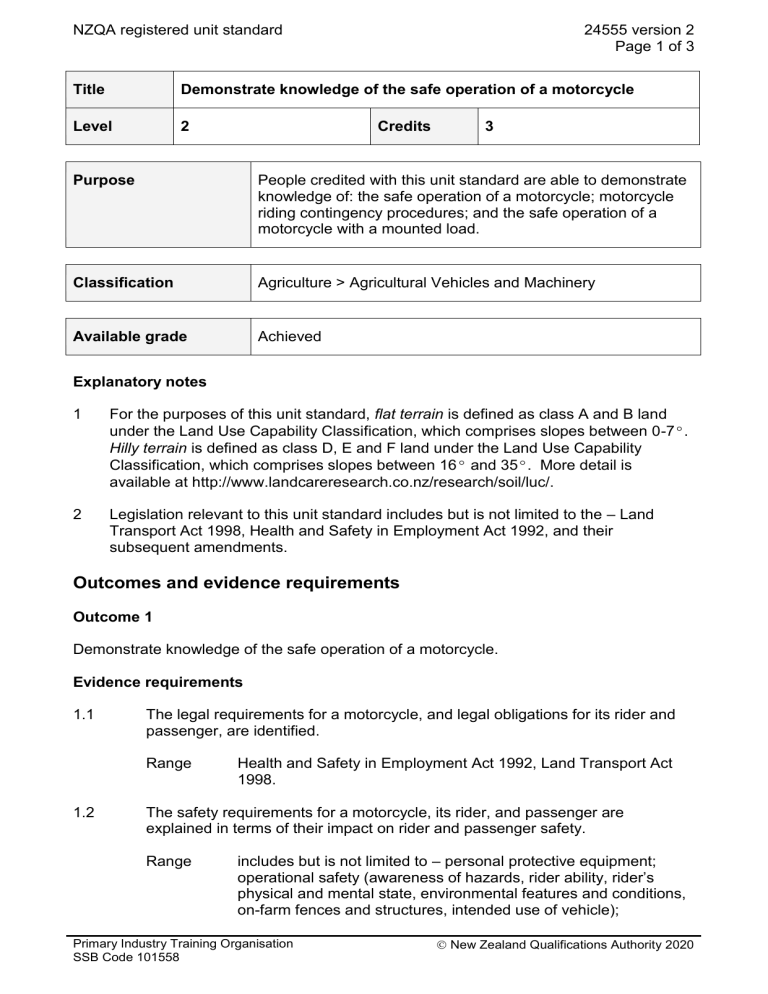
NZQA registered unit standard
Title
24555 version 2
Page 1 of 3
Demonstrate knowledge of the safe operation of a motorcycle
Level
Purpose
2 Credits 3
People credited with this unit standard are able to demonstrate knowledge of: the safe operation of a motorcycle; motorcycle riding contingency procedures; and the safe operation of a motorcycle with a mounted load.
Classification
Available grade
Agriculture > Agricultural Vehicles and Machinery
Achieved
Explanatory notes
1 For the purposes of this unit standard, flat terrain is defined as class A and B land under the Land Use Capability Classification, which comprises slopes between 0-7 º .
Hilly terrain is defined as class D, E and F land under the Land Use Capability
Classification, which comprises slopes between 16 º and 35 º . More detail is available at http://www.landcareresearch.co.nz/research/soil/luc/.
2 Legislation relevant to this unit standard includes but is not limited to the – Land
Transport Act 1998, Health and Safety in Employment Act 1992, and their subsequent amendments.
Outcomes and evidence requirements
Outcome 1
Demonstrate knowledge of the safe operation of a motorcycle.
Evidence requirements
1.1 The legal requirements for a motorcycle, and legal obligations for its rider and passenger, are identified.
Range Health and Safety in Employment Act 1992, Land Transport Act
1998.
1.2 The safety requirements for a motorcycle, its rider, and passenger are explained in terms of their impact on rider and passenger safety.
Range includes but is not limited to
– personal protective equipment; op erational safety (awareness of hazards, rider ability, rider’s physical and mental state, environmental features and conditions, on-farm fences and structures, intended use of vehicle);
Primary Industry Training Organisation
SSB Code 101558
New Zealand Qualifications Authority 2020
NZQA registered unit standard 24555 version 2
Page 2 of 3 vehicle safety (tyres, brakes, maintenance).
1.3 The function and op eration of a motorcycle’s controls and displays are identified.
1.4 The impact of a motorcycle’s dynamics on its safe operation is explained.
Range stability, steering, manoeuvrability, braking and control.
Outcome 2
Demonstrate knowledge of motorcycle riding contingency procedures.
Evidence requirements
2.1 The methods for avoiding and correcting traction loss are identified.
2.2 Active riding techniques and the reasons for using them are explained.
Range weight transfer, balance, body position, head and eye position.
2.3 Methods for safely abandoning a motorcycle in a hazardous situation or loss of control event are identified.
Outcome 3
Demonstrate knowledge of the safe operation of a motorcycle with a mounted load.
Range flat terrain, hilly terrain; static loads, movable loads.
Evidence requirements
3.1 The impact of a mounted load on the dynamics of a motorcycle is explained.
Range dynamics include - steering, manoeuvrability, stability, braking, gear selection, traction.
3.2 Techniques for safely attaching a mounted load on a motorcycle are explained in terms of weight of load, load security, and manufacturer’s specifications.
Replacement information This unit standard, unit standard 24556 and unit standard
24557 replaced unit standard 19057.
Planned review date 31 December 2016
Primary Industry Training Organisation
SSB Code 101558
New Zealand Qualifications Authority 2020
NZQA registered unit standard 24555 version 2
Page 3 of 3
Status information and last date for assessment for superseded versions
Process Version Date Last Date for Assessment
Registration 1 20 May 2008 31 December 2013
Review 2 21 June 2012 N/A
Consent and Moderation Requirements (CMR) reference 0052
This CMR can be accessed at http://www.nzqa.govt.nz/framework/search/index.do.
Please note
Providers must be granted consent to assess against standards (accredited) by NZQA, before they can report credits from assessment against unit standards or deliver courses of study leading to that assessment.
Industry Training Organisations must be granted consent to assess against standards by
NZQA before they can register credits from assessment against unit standards.
Providers and Industry Training Organisations, which have been granted consent and which are assessing against unit standards must engage with the moderation system that applies to those standards.
Requirements for consent to assess and an outline of the moderation system that applies to this standard are outlined in the Consent and Moderation Requirements (CMR). The
CMR also includes useful information about special requirements for organisations wishing to develop education and training programmes, such as minimum qualifications for tutors and assessors, and special resource requirements.
Comments on this unit standard
Please contact the Primary Industry Training Organisation standards@primaryito.ac.nz if you wish to suggest changes to the content of this unit standard.
Primary Industry Training Organisation
SSB Code 101558
New Zealand Qualifications Authority 2020
